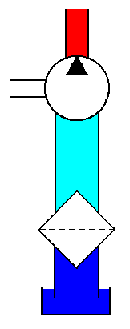 An undesired phenomena in hydraulic systems is cavitation. Most of the time cavitation occurs in the suction part of the system. When cavitation takes place the pressure in the fluid decreases to a level below the ambient pressure thus forming 'caves' or 'vacuumholes' in the fluid. When the pressure increases, for example in the pump, these 'vacuumholes' implode. During this implosion the pressure increases tremendously and the temperature rises to about 1100 degrees Celcius. The high pressure in combination with the high temperature, causes a lot of damage to the hydraulic components. A cavitating pump might be completely damaged in several hours and the wear parts will damage the system.
An undesired phenomena in hydraulic systems is cavitation. Most of the time cavitation occurs in the suction part of the system. When cavitation takes place the pressure in the fluid decreases to a level below the ambient pressure thus forming 'caves' or 'vacuumholes' in the fluid. When the pressure increases, for example in the pump, these 'vacuumholes' implode. During this implosion the pressure increases tremendously and the temperature rises to about 1100 degrees Celcius. The high pressure in combination with the high temperature, causes a lot of damage to the hydraulic components. A cavitating pump might be completely damaged in several hours and the wear parts will damage the system.
cavitation may be caused by:
